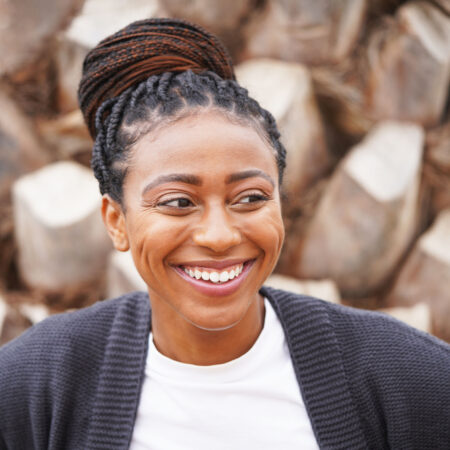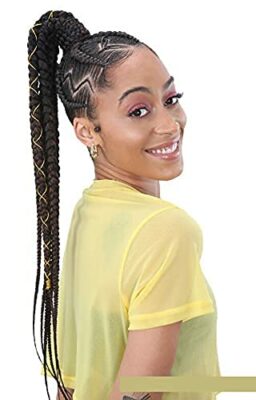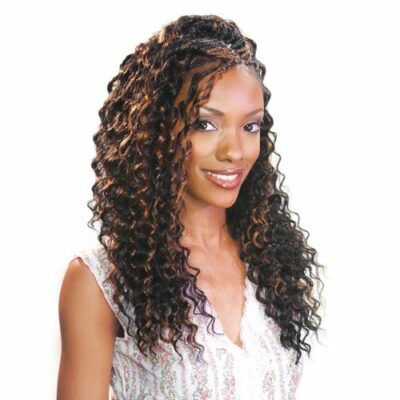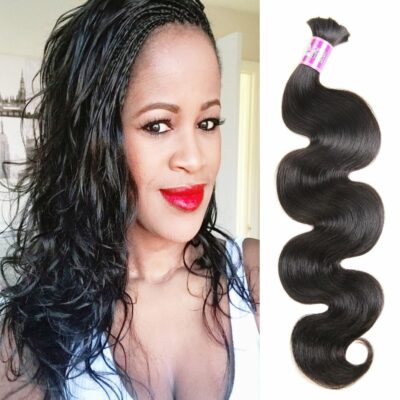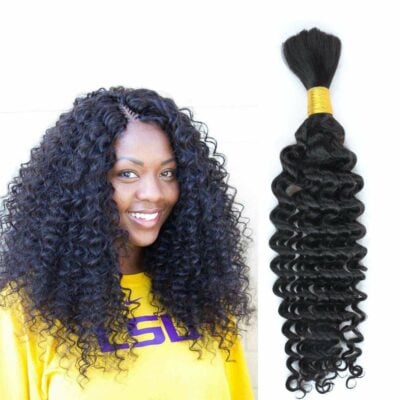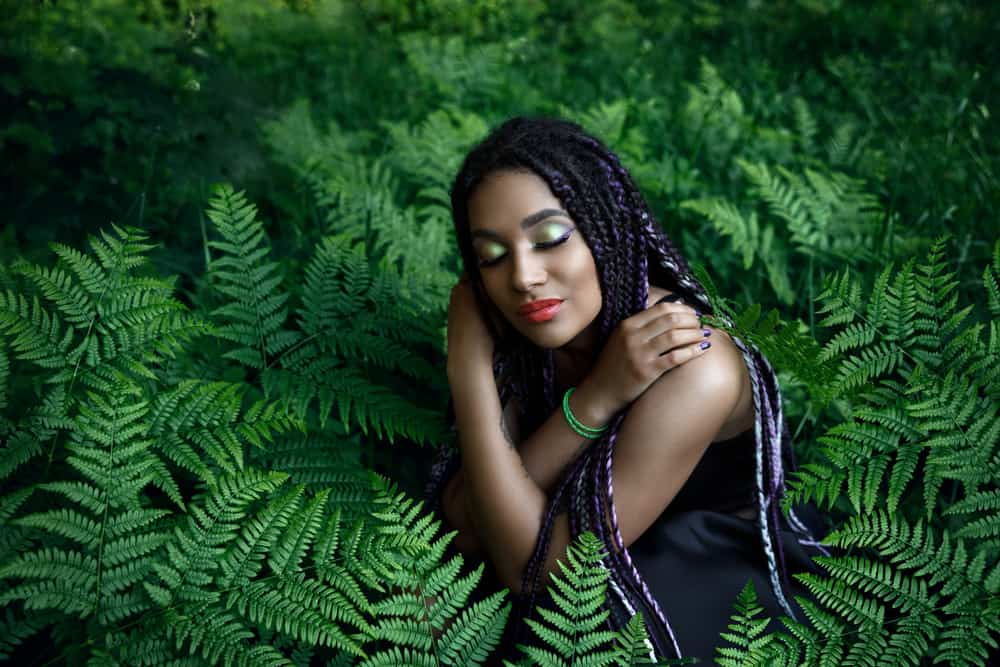African-American and black women often go to the salon to have tree braids done by professionals. It is a popular hairstyle choice because they last for a long time and add a unique style to a person’s look while keeping their natural hair fully protected. They are also an especially popular style during the summer months because they open up the scalp to keep a person’s head breezy and cool.
Important Factors To Consider When Buying Hair for Tree Braids
The kind of hair you’ll need for tree braids will depend entirely on the kind of style you’re going for. Read through the following section to figure out what options are best for you.
What Are Tree Braids?
Tree braids (also known as “invisible braids”) are a hairstyle that is built from cornrowed hair. When the look is completed, no one is able to see the cornrows that started the style. Only the ends of the extension are visible. Because of this, there is almost no limit to the kind of hairstyles you can create through tree braiding. That’s why it’s such a popular choice amongst women!
Best Types of Hair for Tree Braids
There are two options for hair extension to add to your cornrowed hair to create the tree braid look: synthetic or human. Here are the differences between the two choices:
Synthetic Hair
Synthetic hair is the most common type of hair used for tree braids. That’s because it tends to be cheaper than any human hair you can purchase for this style on the market. Additionally, people prefer to use synthetic hair because there tends to be more variety in the types of hair textures and colors you can choose from.
However, there are some negatives to using this type of hair. Synthetic hair will not last as long as human hair in this style. And when it comes to styling the hair after it’s installed, there may be even more limitations as most types of synthetic hair cannot have heat applied to them with curling or straightening irons.
Human Hair
Human hair, on the other hand, has no limits in how it can be styled once it is installed. It can be curled, straightened, braided, etc., in whatever way you choose! This makes human hair options highly desirable for many people.
However, the major downside to using human hair for tree braids is that it is incredibly expensive! Though they are extremely durable and will last longer in the tree braid hairstyle than synthetic hair, they will most definitely put a dent in your wallet.
Professional vs. DIY Installation
If you are confident in your hairstyling abilities, it is quite possible for you to buy your own hair and install tree braids for yourself in the comfort of your home. Putting them in can be done in four simple steps.
However, if you’re not very confident in the hairstyling department, it’s best that you seek out professional help to get the job done. Professional stylists will know exactly what to do and will have no problem working with your hair.
Just be sure to do your research and seek out a salon with professionals who have a wealth of experience doing both cornrows and tree braids. Remember, these are two very different (and very important skills) to have to do this hairstyle!
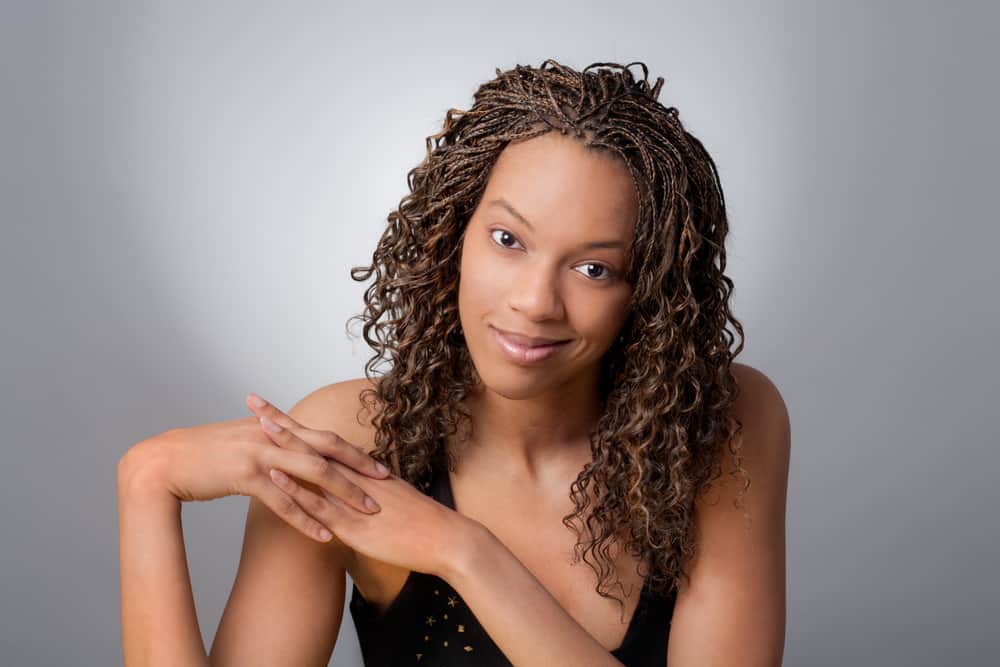
Top 5 Best Hair for Tree Braids 2025
1. Best Overall: FreeTress Jumbo Braiding Hair
Editor’s Rating:
Quick Facts:
- Color: 1B
- Material: Synthetic
- Installation Type: Weave
FreeTress Jumbo Braiding Hair is pre-stretched, making it easy to braid into your natural hair. Each package you purchase comes with three lengths of hair for braiding, and every bunch of hair is approximately 28” in length.
This hair blends best with afro/curly textured hair for the most seamless and natural look. Other hair types may not hold the hair as well. Customers will like how soft the hair is to the touch and that it makes the braiding process quick and easy on the fingers! However, sometimes this softness can make the hair hard to untangle and sometimes feel itchy.
Pros
- Three lengths of hair are provided in each pack
- Is easy to manage as it’s soft and easy to brush
- Has a naturally blown-out texture for the perfect “just out of the salon” look
- Blends easily with afro and curly textured hair
Cons
- May be hard initially to untangle hair straight out of the package
- Some find the texture itchy and uncomfortable
Editor’s Rating:
Quick Facts:
- Color: 1B
- Material: Synthetic
- Installation Type: Clip
FreeTress Deep Twist Braiding Hair is 22” in length and is easy to install in your natural hair. The hair creates a look that is light and bouncy, and it’s long enough for you to choose just how long or short you’d like it to be!
You can purchase this hair in a pack of four or a pack of six, and there are also twenty different color options to choose from. These braids will need a lot of constant, regular maintenance to keep them looking fresh, but it’s totally worth the effort!
Pros
- Easy to install into your natural hair
- Creates a light and bouncy look with beautifully defined curls
- Comes in twenty color options and two package options
Cons
- Hair detangles and sheds quite easily
- May cause an allergic reaction for people with sensitive skin
3. Best Budget: ZSF Brazilian Hair
Editor’s Rating:
Quick Facts:
- Color: Natural Black
- Material: Human
- Installation Type: Sew-In
ZSF Brazilian Hair is natural human hair that can be bought in a number of length combinations, ranging from 14” – 28”. Customers will love the variety of choices as they provide hair in a combination of varying lengths. This ensures that customers can create that beautiful, layered look!
The hair is gorgeously soft and wavy, making it easy to install in your natural hair. However, some customers with thinner natural hair may find that it slips from their natural hair more quickly after it has been installed.
Pros
- The hair is super soft, making it easy to install and manage
- Customer service is open and actively communicative
- Does not shed as easily as other brands
Cons
- Some may experience more slippage after installation than others
4. Hannah Deep Weave Bulk Braiding Hair
Editor’s Rating:
Quick Facts:
- Color: 1B
- Material: Human
- Installation Type: Weave
Hannah Deep Weave Bulk Braiding Hair is super curly and super soft to the touch, making it easy to install into your natural hair. Customers will appreciate the light, bouncy look of this natural hair. And if you want to try to style it a different way, you have the option to color, straighten and/or perm this hair!
You can purchase this in a 50g or 100g pack, and you also have a variety of lengths to choose from, ranging from 16” to 26” in length. Additionally, the packaging can be purchased in a variety of lengths if you want to create a more layered look.
Pros
- Hair is high quality and super soft to the touch
- Comes with three bundles of hair per package
- Can be styled (e.g., colored, straightened, permed, etc.)
Cons
- Hair can shed quite easily with certain hair types/styles
5. Deep Bulk Braiding Hair
Editor’s Rating:
Quick Facts:
- Color: 1B
- Material: Human
- Installation Type: Weave
Deep Bulk Braiding Hair is a blend of mostly human hair with a small percentage of synthetic. You can purchase it in a variety of lengths, ranging from 18-20”. We love the loose, spiraled, curled look this hair creates at the ends, and we especially appreciate how long-lasting this hair is once installed.
Pros
- Hair can last up to 4 months and be redone to last even longer
- Tangles less than other brands of hair
- Hair is soft to the touch and easy to install/maintain
Cons
- Not 100% human hair (a mixture of approximately 15-20% of synthetic)
Buying the Best Hair for Tree Braids
In the following section, we’ll review the most important factors to consider when buying hair for tree braids. We’ll also discuss some additional things to keep in mind before you buy hair for tree braids that’ll best suit your needs.
The History of Tree Braids
Tree braids cannot be created unless you first start with cornrows. This style of braiding hair dates back to approximately 3,000 BCE! A civilization known as Nok (around 500 BCE) was famous for wearing cornrows. To them, the hairstyle symbolized their religious, social, and cultural values.
Cornrows disappeared from African hairstyles during slavery because enslavers would shave their heads during their forced migration to the “New World.” However, after time, enslaved Africans would reintroduce cornrows to their everyday hairstyle as enslavers required them to keep their hair neat and tidy.
There was another surge in popularity for the cornrow hairstyle during the 1960s, particularly in conjunction with the Black Power movement. They used cornrows to distinguish new members from older, more seasoned ones.
Not only are cornrows popular today to aid in the installation of tree braids, but they continue to be a popular hairstyle in general in the US, West Africa, and the South Horn of Africa. In African countries, they are worn to communicate one’s identity as it relates to religious beliefs, marital status, age, etc.
Synthetic vs. Human Hair for Tree Braids
There are only two choices of extensions for tree braids: synthetic and human. Most people go for the synthetic option because it’s cheaper, and there are more color and texture choices to choose from. However, if you’re not afraid of putting a little dent in your wallet, human hair is the better choice if you want to be able to style your tree braids using curling or straightening irons after they’re installed.
How To Install Tree Braids
If you’re comfortable installing your own tree braids at home, it can be done in five simple steps once you’ve bought the right hair extensions for you:
- Apply some type of moisturizing scalp treatment (like shea butter) into the roots of the hair to ensure better scalp protection.
- Divide a section of your hair along the hairline that is no bigger than a ½ inch. Clip that section firmly into place.
- At the hairline, start to form a cornrow braid. Add in the extension hair to the braid as you go along.
- Continue to braid your real hair and the extension hair together until you are certain that the extension hair is securely attached to your head. (Most of your extension hair should be unbraided and free-flowing.)
- Repeat steps 1-3 until all of your hairline has been braided with the extension hair.
How To Maintain and Care for Your Tree Braids
Once your tree braids are in, you’ll need to take care of them. This will ensure that the hair lasts for as long as possible and that you keep it clean and hygienic while rocking your hairdo!
Remember to check back with your hair stylist every 8-10 weeks to get your hair rebraided or help remove them altogether. This is especially important if your braids get too loose or begin to fall out.
Cleaning Human Hair
If you are working with human hair, taking care of your tree braids should be straightforward and simple. Simply shampoo and condition your braids just like you would your normal hair.
Cleaning Synthetic Hair
If you are working with synthetic hair, you only need to wash your braids once every 1-2 weeks. Do not use regular shampoo and conditioner. Rather, make a diluted shampoo with ½ a teaspoon of gentle shampoo (baby shampoo will work just fine!) mixed with 1 quart of cold or room temperature water.
Between shampooing sessions, be sure to spray your tree braids with detangling spray. This will help moisturize your braids, so that you can more easily brush through your hair and comb out any knots that have developed.
Scalp Care
You will also need to pay close attention to your scalp while your tree braids are in. It’s not all about maintaining just the hair! The braids along your scalp may look messy or undone if you scrub too vigorously between the braids and the scalp, so wash along these areas with extreme care.
This can be avoided by applying a waterless shampoo to the scalp area after you’ve properly washed your tree braids. You also have the option to use an astringent to clean around the braids on the scalp like African Pride Black Castor Miracle, Girl + Hair Under Hair Care, or DevaCurl Buildup Buster.
How To Remove Tree Braids
The easiest and most efficient way to remove your tree braids is to go to the hair salon of your choice and have a person specializing in tree braids and cornrows do it for you. However, if you’re more of a DIYer, here are the steps to follow to ensure that you remove them safely without damaging your natural hair:
- Detangle the tree braids with a wide-toothed comb.
- Choose the braid you’d like to remove and clip the rest out of the way.
- Cut the hair extension a far ways away from where the knot was made to your natural hair.
- Spray the braid with detangling spray.
- Unbraid the braid starting from the bottom and working your way up.
- Unravel the tree braid hair and discard it before moving on to the next braid.
- Continue steps 1-6 until all the tree braids are removed.
FAQs on Hair for Tree Braids
How long do tree braids last?
If properly cared for, tree braids can last up to six weeks!
Why are they called tree braids?
They are called tree braids because they are a protective hairstyle that resembles a tree once they are installed.
Are tree braids the same as microbraids?
No, they are not. Tree braids use the cornrow method, and microbraids do not.
Can I still be active while wearing tree braids?
Tree braids are really flexible! So long as you make sure to care for them properly, you should be able to work out, swim, shower, and do whatever you normally do while you have them in.
Final Thoughts
Whether you’re donning a tree braid style to keep cooler in the summer or just wanting to change up your look, knowing the best type of hair to use will make all the difference! Now that you know what to look for in tree braid hair, you’re sure to rock a glamorous new look that’ll have you feeling gorgeous!
